Did you know it was elements of South African armoured formations which were the first to enter the Italian city of Florence and given the honour of liberating it? Chances are most people would not have a clue, the honour given to military formations of liberating capital and regional capital cities like Florence during World War 2 was a very big deal, but sadly in South Africa this very big feather in our military cap is lost to the majority.
The very fact that the iconic worldwide heritage bridge in central Florence – the Ponte Vecchio – still stands is thanks to South African armoured regiments who were the first to get to it and secure it, when all the other iconic historic bridges of Florence were blown into smithereens by the retreating German forces.
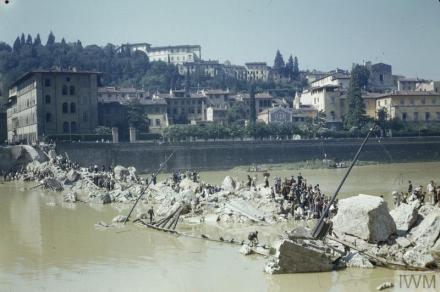
Civilians clambering over the ruins of the Ponte Alle Grazia, one of the bridges over the River Arno destroyed by the Germans before evacuating Florence.
The latter half the Italian campaign during World War 2 was all about the race of various units and ‘nations’ to liberate a city, a great emphasis was placed on the ‘honour’ that a particular formation would receive for doing it, the American’s had the honour of liberating ‘Rome’ it was given to the American 5th Army who secured the centre, the American 1st Armored Division (old ironsides) liberated Milan and Bologna’s liberation is given to the Eighth Army’s Polish II Corps’ 3rd Carpathian Infantry Division.
So, unknown to many South African’s our military has the honour of liberating Tuscany’s regional capital – Florence, an honour simply not placed on the country’s ‘national christian’ education curriculum of the old national party (who regarded the whole episode of South Africa’s WW2 campaign as one of Smuts’ folly and treachery) and now not even on the radar for any young South African studying our history.
In setting the narrative straight and re-kindling this honour, let’s have a look at what happened and ‘whodunnit’.
The Liberation of Florence
In a nutshell, the South African 6th Armoured Division, fighting at the crucible of the Italian campaign against Nazi German forces, spearheaded the Allied advance into Florence in August 1944. They were followed closely by the New Zealanders and then the British forces – as this short news clip from United News at the time recalls.
On 20 July General Kirkman XIII Corps commander, issued orders for a “…powerful thrust to seize all crossings across the River Arno to the west of Florence.” This effort was to be concentrated on the 6th South African Armoured Division front. The advance was to be led by the South African Division with the 4th Infantry Division to its right, supported on the flanks by the 6th British Armoured Division and the 8th Indian Infantry Division.
The Allies advanced through Greve and were stopped by the German 4th Parachute Division on the River Greve on 24 July. The Allies had, however, outflanked the German Parachute Division, who then withdrew during the night of 24/25 July, allowing the South African, New Zealand and Indian Divisions to advance to the Paula Line which was reached on 28 July.
General Kirkman again placed the South African and New Zealand Divisions as the spearhead of his Corps advance, this time to break the Paula Line and to take Florence. By the 3rd of August columns of South African, New Zealand and 4th Infantry Divisions were advancing towards Florence. By 4 August, advance parties of South Africans and New Zealanders were exploring the outskirts of Florence to find that all bridges across the Arno River viable for military transport had been destroyed by the retreating Germans.
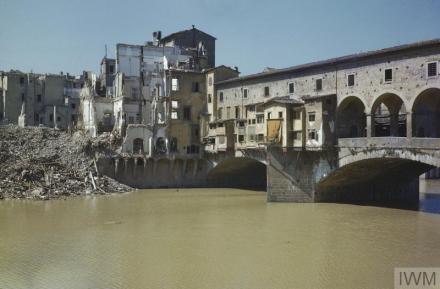
View of the damage to the Ponte Vecchio from the east. The German forces destroyed all of the bridges over the River Arno with the exception of the Ponte Vecchio before evacuating Florence.
A South African armoured patrol, made up of the South African Imperial Light Horse and the Kimberley Regiment raced into central Florence and found the smaller (and iconic) Ponte Vecchio bridge intact, they crossed it under heavy shelling, entering into the centre of the city at 4 am on the 4th August 1944, to be crowned as the first Allied troops to enter Florence.
This wonderful image captures the moment, here a Sherman artillery OP tank of the 22nd Field Regiment, South African 6th Armoured Division, enters Florence through the Porta Romano, 4 August 1944.
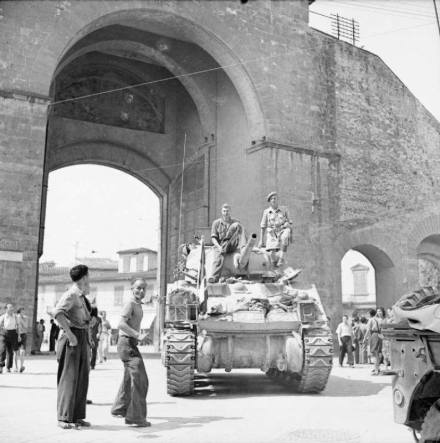
South African 6th Armoured Division entering Florence through the Porta Romano, 4 August 1944.
In Conclusion
Over the years New Zealand have laid the claim of liberating Florence, and in that country it is a very big deal, however not to detract the New Zealand sacrifice (they were shoulder to shoulder with the South Africans in this particular fight) but is a sad fact is that nobody has really challenged New Zealand on this claim such is general apathy and lack of national pride in South Africa for our World War 2 sacrifice and battle honours.
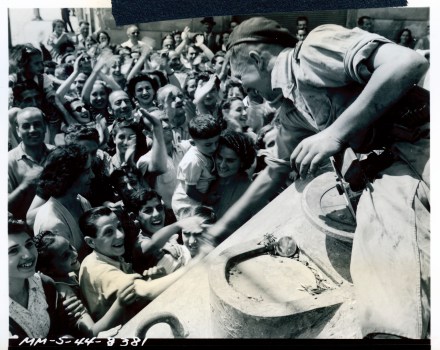
South African tank crew in Florence, Italy on 7 August 1944 shakes the hands of cheering Italians welcoming liberation. From The Digital Collections of the National WWII Museum
The truth (and historic fact) is that it was a South African armoured regiment that secured the Ponte Vecchio bridge and entered the city first, it was the South Africans who were charged with the main spearhead and it is on both the historical record and media record at the time that the South Africans have the honour of liberating Florence.
So there you have it, another ‘Inside the Chappie wrapper’ interesting fact for the day and another reason to stand proud of South Africans. The beautiful and historic city of Florence, the jewel of Tuscany and its central pride, the medieval Ponte Vecchio – all now enjoyed by a grateful nation and the world at large as an international heritage site, and it’s largely thanks to a heroic bunch of South Africans.

Researched and written by Peter Dickens. Primary sources – Wikipedia and the Imperial War Museum. Images, Imperial War Museum copyright.
Movie Clip copyright. National Archives and Records Administration – ARC 39132, LI 208-UN-1013 – Allies Liberate Florence (1945). Series: Motion Picture Films from “United News” Newsreels, compiled 1942 – 1945.

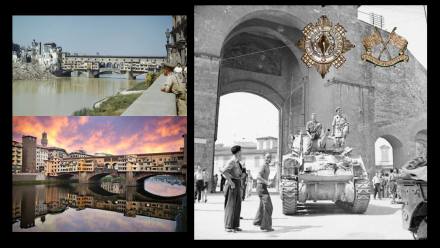
Yes I actually know this as I myself was a member of UMR and 1SSB.
And actually spend some time reading the honors roll at UMR and as a unit they actually have a lot of Honors. And believe they were also involved in the Korea war fighting side by side with their American Brothers in arms.
I also used to go to the war museum in Durban South Africa which had an Awesome collection of war memorials, and so dus UMR.
Beside all the war stuff they also had the pig and whistle,which was on of the most fun pubs and have found memories.:-))))))
Thank you for posting this article that is actually a true fact, I am now an American Citizen and proud of it and thankful that they felt that I have paid it foward and worthy to be an American. I do miss my Country of birth.
I dit not become an American because of the madness what is now going on in South Africa it’s hard to see and understand what is happening.
I became an American as I truly believe I always was an American just born on the wrong continent. I pray every day for every South African that things will change, but it’s not it’s if you wish it will never rain again but it will.
So once more thank you for posthing and being Awesome, I hope your new year is full of beautiful moments and that every day have something special in it for you and your family, thank you.
Kind Regards
Hugh Ford
LikeLike
Great bit of history, not celebrated in the annals of South Africa, for at the time great devide over participation of war effort although again history has shown it the right thing to do.
LikeLike
Who liberated what & when? The fog of war!
New Zealanders – in 2011 – regained the honour of ‘liberating’ the small town of Tavarnelle to the south-east of Florence. For decades townsfolk had believed they were liberated from German occupation by black American soldiers. But …… read on:
http://www.stuff.co.nz/national/5501237/Italian-town-confuses-its-liberators.
Florence? Methinks Peter that you’re a wee bit out of date.
In his recent, and excellent, history of the 2nd NZ Division, “A Bloody Road Home” published in 2016, New Zealander Chris Pugsley quotes General Oliver Leese, the 8th Army commander: “The New Zealand Division fought magnificently over a period of four days. If it had not been for their effort it would have been necessary to check along the whole front until we could bring in fresh divisions. In conformity with the New Zealanders, progress was made all along the line, especially by the 4th British and 6th South African Divisions. And on 4th August, the South African Division and their 24th Guards Brigade entered the southern outskirts of FLORENCE. It was fitting that this division should have been the first to enter FLORENCE as they had fought continuously and extremely well during the whole advance northwards from ROME”.
There you are Peter – in print and acknowledged by a Kiwi military historian!
LikeLiked by 1 person
Thank you Mike, remind me I need to do an article of the close fighting relationship between New Zealanders and South Africans and all the ‘unofficial’ rugby union test matches held during the war – from North Africa to Italy.
LikeLike
I’ll look forward to reading that Peter. 🙂
Mike
LikeLike
My late father was in the Kimberley Regiment and always spoke about the South Africans being the first to enter Florence and secure the Ponte Vecchio.
LikeLike
Whenever I think of WW2 the first thing that comes to mind is my great grand mother being pushed out of Europe by the Nazis. I don’t know why.
LikeLike
My Dad lost both his legs. Below the knees in Honey tank, liberating Florence. Amazing man.
Beautiful wife …three sons. I see I can buy a Honey tank for about $150,000.00. But who knows what it will cost to bring it to Cape Town, South Africa?
My dad was in the South African army (SSB..Special Services Battalion) at the age of 16, lying about his age…South Africa had no conscription in 1939-1945.
I am at duffett@telkomsa.net
Ron Duffett..
LikeLike
I think that the man on the right standing up on the tank entering through
the Porta Romana is my father, Lieutenant Jacques Pierre Niehaus of
the Pretoria Regiment. I would love to have confirmation of this.
We visited Florence as a family several times during the 1950’s
as he developed a great love for Italy
LikeLike
Pingback: The Book! | The Observation Post